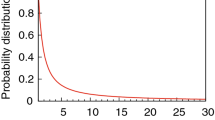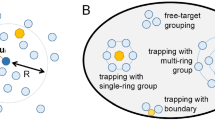Abstract
Collective task in swarm robots has been studied widely because of the ability limitation of a single robot. Collective tracking is an important ability for swarm, and many of previous tracking tasks are based on leader-follower model. Unfortunately, simple following behavior brings much tracking uncertainty in constrained environment and difficulty for a convergence tracking pattern. To address this issue, we propose a new model for tracking by combining tracking-based hierarchical gene regulatory network with leader-follower model named (TH-GRN) for swarm robots. The TH-GRN model simulates the process that proteins are generated and diffused to control swarm activities. The concentration diffusion forms a tracking pattern and guides swarm robots to designated pattern. In order to be adaptive to confined environment, some flexible strategies are devised and integrated into our proposed TH-GRN model to achieve better performance. Besides, the TH-GRN model is also used to generate dynamic and complex environment. In our experiments, we design three obstacle scenarios, i.e., fixed obstacles, mobile (dynamic) obstacles, and hybrid obstacles. We conduct some simulation to validate the effectiveness of tracking-based TH-GRN model, and the experiment results demonstrate the superiority of our model.
Access this chapter
Tax calculation will be finalised at checkout
Purchases are for personal use only
Similar content being viewed by others
References
Mastellone, S., Stipanovic, D.M., Spong, M.W.: Remote formation control and collision avoidance for multi-agent nonholonomic systems. In: Proceedings of the 2007 IEEE International Conference on Robotics and Automation, pp. 1062–1067 (2007)
Franks, N.R., Richardson, T.: Teaching in tandem-running ants. Nature 439(7073), 153 (2006)
Krieger, M.J.B., Billeter, J.-B., Keller, L.: Ant-like task allocation and recruitment in cooperative robots. Nature 406(6799), 992 (2000)
Oh, H., et al.: Bio-inspired self-organising multi-robot pattern formation: a review. Robot. Auton. Syst. 91, 83–100 (2017)
Oh, H., et al.: Decentralised standoff tracking of moving targets using adaptive sliding mode control for UAVs. J. Intell. Robot. Syst. 76(1), 169–183 (2014)
Chen, X., et al.: Formation control of mobile robots with input constraints: an elliptic approximation approach. In: 2011 11th International Conference on Control, Automation and Systems, pp. 186–191 (2011)
Guo, H., Meng, Y., Jin, Y.: A cellular mechanism for multi-robot construction via evolutionary multi-objective optimization of a gene regulatory network. BioSystems 98(3), 193–203 (2009)
Guo, H., Meng, Y., Jin, Y.: Swarm robot pattern formation using a morphogenetic multi-cellular based self-organizing algorithm. In: 2011 IEEE International Conference on Robotics and Automation, pp. 3205–3210 (2011)
Piegl, L., Tiller, W.: The NURBS Book, pp. 117–139 (1997)
Oh, H., Jin, Y.: Adaptive swarm robot region coverage using gene regulatory networks. In: Mistry, M., Leonardis, A., Witkowski, M., Melhuish, C. (eds.) TAROS 2014. LNCS (LNAI), vol. 8717, pp. 197–208. Springer, Cham (2014). https://doi.org/10.1007/978-3-319-10401-0_18
Oh, H., Jin, Y.: Evolving hierarchical gene regulatory networks for morphogenetic pattern formation of swarm robots. In: 2014 IEEE Congress on Evolutionary Computation (CEC). IEEE (2014)
Peng, X., Zhang, S., Huang, Y.: Pattern formation in constrained environments: a swarm robot target trapping method. In: 2016 International Conference on Advanced Robotics and Mechatronics (ICARM), pp. 455–460 (2016)
Zhang, S., et al.: Multi-target trapping with swarm robots based on pattern formation. Robot. Auton. Syst. 106, 1–13 (2018)
Oh, H., Shiraz, A.R., Jin, Y.: Morphogen diffusion algorithms for tracking and herding using a swarm of kilobots. Soft Comput. 22(6), 1833–1844 (2018)
Acknowledgements
This research work was supported by Guangdong Key Laboratory of Digital Signal and Image Processing, and the National Defense Technology Innovation Special Zone Projects.
Author information
Authors and Affiliations
Corresponding author
Editor information
Editors and Affiliations
Rights and permissions
Copyright information
© 2019 Springer Nature Switzerland AG
About this paper
Cite this paper
Yuan, Y. et al. (2019). TH-GRN Model Based Collective Tracking in Confined Environment. In: Tan, Y., Shi, Y., Niu, B. (eds) Advances in Swarm Intelligence. ICSI 2019. Lecture Notes in Computer Science(), vol 11656. Springer, Cham. https://doi.org/10.1007/978-3-030-26354-6_4
Download citation
DOI: https://doi.org/10.1007/978-3-030-26354-6_4
Published:
Publisher Name: Springer, Cham
Print ISBN: 978-3-030-26353-9
Online ISBN: 978-3-030-26354-6
eBook Packages: Computer ScienceComputer Science (R0)




